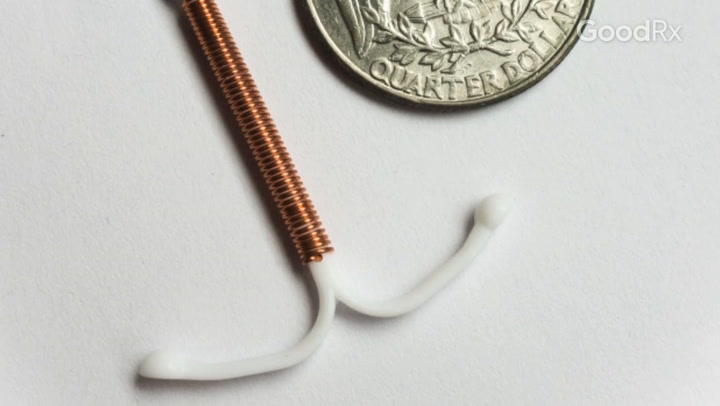
10 Paragard (Copper IUD) Side Effects You Should Know About
Key takeaways:
Paragard is a copper intrauterine device (IUD) that doesn’t contain any hormones. But it does have some side effects to be aware of.
Less serious Paragard side effects can include longer or heavier periods. These side effects typically start to improve after 3 to 6 months.
More serious Paragard side effects — like IUD movement, infection, and ectopic pregnancy — are rare but can happen. Contact your healthcare provider right away if you have symptoms of serious side effects.
Table of contents

The Paragard intrauterine device (IUD) is a long-acting, hormone-free, and reversible birth control device. This copper IUD can be a convenient option for people who want to skip the pill or hormones altogether. However, it still has the potential for side effects. Some can be bothersome but manageable, while others can be more serious.
Since Paragard is hormone-free, you may experience side effects that are different from those you might experience with hormonal birth control options. The IUD also contains copper, which can be a problem for certain women. Here we’ll discuss 10 Paragard side effects and what to do if you experience them.
1. Increased cramping and heavier periods
It’s normal to experience cramping during and after Paragard insertion. For some, cramping resolves quickly. But, for others, this side effect may last for a few weeks.
Paragard can also cause you to have more cramping with periods and make your periods heavier or last longer. These period changes were the most common reason women stopped using Paragard in clinical trials. The good news is that these side effects usually start to improve after 3 to 6 months.
Over-the-counter (OTC) pain relievers may help with cramping from Paragard. These include ibuprofen (Advil, Motrin), naproxen (Aleve), or acetaminophen (Tylenol). Placing a heating pad on your lower belly can also help.
2. Breakthrough bleeding or spotting
In addition to heavier or longer periods, you may notice breakthrough bleeding or spotting with Paragard. This should also improve within 3 to 6 months.
However, bleeding can also be a sign of more serious Paragard side effects. These side effects include IUD movement, infection, and pregnancy outside of the uterus (ectopic pregnancy). Contact your provider right away if your bleeding is accompanied by other symptoms, like pain or fever.
3. Pain during sex
Some women experience pain during sex, called dyspareunia, with Paragard. It’s important to let your healthcare provider know if this happens. Painful sex can be a sign of an infection or of your IUD moving out of place.
4. Back pain
It’s possible you’ll experience back pain with Paragard, especially in the days after the IUD is inserted. Similar to cramping, back pain can be managed with OTC pain relievers and/or a heating pad. And it should also improve over time. However, lower back pain can also be a symptom of an ectopic pregnancy, which is covered later.
5. Vaginitis
Some women develop vaginitis, or inflammation of the vagina, with Paragard. If this happens, you may notice symptoms such as itching or burning, abnormal discharge, or an unpleasant odor.
In some cases, vaginitis from Paragard may be caused by bacterial vaginosis — a type of bacterial infection. And you may need to take an antibiotic pill, or apply a prescription cream or gel, to treat it. While rare, abnormal odor or discharge can also be symptoms of pelvic inflammatory disease (PID).
Contact your healthcare provider if you notice any changes in vaginal odor or discharge, or if you experience itching or irritation. Your provider can figure out the cause and how to treat it.
6. Anemia
As mentioned above, you may experience heavier periods with Paragard. This increased blood loss every month can heighten your risk of iron-deficiency anemia. This is when your iron levels are low, resulting in fewer red blood cells being made.
If you develop anemia, you may not notice any obvious symptoms. But a few possible signs and symptoms are tiredness or dizziness, headaches, and brittle nails or hair loss.
Let your healthcare provider know if you experience any of these symptoms. If needed, they may have you take iron supplements to get your levels back to normal.
7. IUD expulsion or movement
Although uncommon, IUD expulsion can happen when using Paragard. This is when the IUD is partially or completely pushed out of the uterus.
There’s also a small risk of the IUD moving and becoming embedded (stuck) in the wall of the uterus. If this happens, it can be difficult to remove and surgery may be required.
A Paragard IUD can also move to another area of the body if it goes through part of the uterus. IUD movement can cause pain, bleeding, or no symptoms at all.
Two thin threads from the IUD should hang out of your cervix after Paragard is placed. Check for the threads once a month to ensure it’s still in the right place. Your healthcare provider will give you tips about how to check for the threads.
Contact your healthcare provider if you notice the threads feel shorter or longer, or if you can’t feel them at all. You’ll need to be checked to make sure your IUD is still in place and that it hasn’t moved.
Keep in mind: If the IUD moves out of place, you aren’t protected against pregnancy.
8. Ectopic pregnancy
An ectopic pregnancy is a pregnancy that starts outside of the uterus. An ectopic pregnancy can be dangerous and even life-threatening. It can also affect your future fertility.
Paragard works well to prevent pregnancy. But getting pregnant while a Paragard IUD is in place raises the likelihood that the pregnancy will be ectopic. Contact your healthcare provider immediately if you become pregnant while using Paragard.
Unexpected vaginal bleeding, abdominal pain or cramping, and low back pain may be symptoms of an ectopic pregnancy. Contact your healthcare provider immediately if you have these symptoms.
9. Pelvic inflammatory disease
As discussed earlier, there’s a small risk that a serious infection called pelvic inflammatory disease (PID) could happen after your IUD is placed. That’s because bacteria could enter your uterus during the process. PID is more likely to happen within the first 3 weeks after placement.
If left untreated, PID can cause scarring of the fallopian tubes. These are the tubes that allow an egg to travel from the ovary to the uterus. This scarring can also raise your risk of ectopic pregnancies and infertility. Symptoms of PID include fever, lower abdominal pain, and unusual vaginal discharge and odor. Contact your healthcare provider if you experience any of these symptoms.
You shouldn’t have Paragard placed if you currently have PID or an untreated sexually transmitted infection (STI). An existing STI can put you at a higher risk of developing PID after insertion.
10. Copper toxicity
Another possible severe side effect of Paragard is copper toxicity. This is a buildup of copper in the body that can be harmful. Symptoms include headache, vomiting, and diarrhea. Dark stool, blood in your vomit, and abdominal pain are also possible. Contact your provider if you experience any of these symptoms while using Paragard.
Copper toxicity from Paragard is rare. But it’s typically more likely to happen if you have a rare genetic condition called Wilson disease. Wilson disease causes copper to build up in your body. Because of this, you shouldn’t use Paragard if you have this condition.
When should you contact your healthcare provider about Paragard side effects?
Some of the possible side effects of Paragard, like menstrual cycle changes, are more common and less serious than others. But they may end up being a reason that this IUD isn’t right for you. If your periods are unmanageable after 3 to 6 months, consider contacting your healthcare provider about other birth control options.
As mentioned, serious Paragard side effects are also possible. If you experience any symptoms associated with a serious side effect listed above or if you become pregnant while using Paragard, contact your healthcare provider right away. If any of your symptoms feel severe or life-threatening, go to your nearest emergency room.
The bottom line
The Paragard intrauterine device (IUD) is a long-acting and reversible form of birth control. The copper IUD is hormone-free, but it still has the potential for side effects.
Common Paragard side effects include longer or heavier periods, cramping, and back pain. More serious side effects — like IUD movement, infection, and ectopic pregnancy — can also occur. If you have symptoms of serious side effects, you should contact your healthcare provider right away.
Why trust our experts?



References
Centers for Disease Control and Prevention. (2022). STD facts - Pelvic inflammatory disease.
CooperSurgical, Inc. (2020). Paragard [package insert].
National Organization for Rare Disorders. (2018). Wilson disease.
Peebles, K., et al. (2021). Elevated risk of bacterial vaginosis among users of the copper intrauterine device: A prospective longitudinal cohort study. Clinical Infectious Diseases.
Planned Parenthood. (n.d.). What are the side effects of IUDs?
Royer, A., et al. (2022). Copper toxicity. StatPearls.
U.S. Department of Health and Human Services Office on Women’s Health. (2021). Iron-deficiency anemia.
Was this page helpful?
Related Articles
Browse medications
View AllResearch prescriptions and over-the-counter medications from A to Z, compare drug prices, and start saving.









